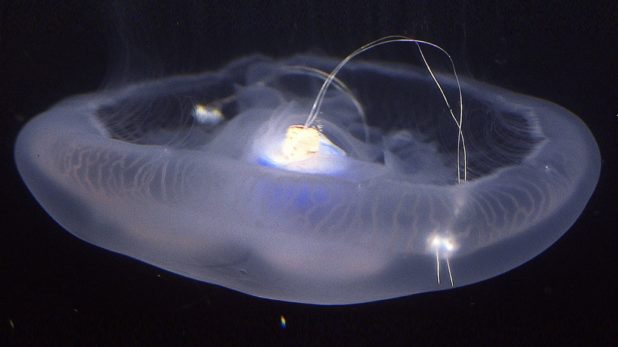Adrian Sol
Daily Stormer
February 2, 2020
It is believed that these new cyber-jellyfish look like this, in classic Mega Man fashion.
It’s every man’s dream to kidnap wild animals and “soup them up” with cybernetic implants, eventually assembling these creations into some kind of “cyborg army” to take over the world.
Okay, it’s not every man’s dream to do that.
But it’s certainly my dream, okay?
And I’m not the only one. Countless many Some scientists share the same vision, and are working to achieve it as we speak.
They could also possibly look a bit like this, if the engineers were more into Mega Man X instead.
I can only hope that no one builds a cybernetic boy and programs him to barge in and wreck all these wonderful cybernetic animals. Sigh.
The only weakness of cybernetic animals is energy blasts – and fast-moving rail carts.
In any case, this new development in cyborg animals is quite exciting. Their choice of base material (jellyfish), however, is a bit disappointing.
Jellyfish are the most efficient swimmers in the ocean, albeit fairly slow ones. Researchers at Stanford University made a jellyfish swim three times faster by sticking a motor to it, creating a biohybrid robot with the jellyfish as the “scaffold.”
The swimming cyborg was 10 to 1,000 times more energy efficient than other swimming robots, according to the paper published in Science Advances. The two researchers behind the study, Stanford graduate student Nicole Wu and professor John Dabiri, hope their robot could be used for ocean monitoring or taking underwater samples.
The researchers obtained dinner-plate sized moon jellies from the Cabrillo Marine Aquarium in San Pedro, California and moved them to a large artificial saltwater tank. They designed a weighted waterproofed controller with a lithium polymer battery, microprocessor, and set of electrodes, which they embedded into the jellyfish’s muscle tissue—kind of like a pacemaker for a heart, but in this case, what looks like a bottle cap filled with electronics stabbed into the jellyfish with a toothpick to make it move faster. The controller generated electrical waveforms and injected them into the jelly muscles.
Creepy – in a good way!
I wish my body was filled with electrodes so that I could move myself with a game controller. Sigh.
I like that these people are just openly doing research with strong “mad scientist” vibes going on, and they’re not afraid of what the sheeple might think.
This is exactly the kind of science that needs to be conducted to bring forth the kind of bad-ass future you might see in a movie, video game or anime. None of this gay “AIDS cure research” crap most scientists are up to.
Just pure “stuffing electronics into live animals” tier stuff.
Bravo.
The researchers, anticipating ethical objections to this work, noted that moon jellies “are invertebrate animals with no central nervous system or reported nociceptors. However, we took steps to ensure that no unnecessary tissue damage occurred during experiments.”
Three experimental trials followed: one to just observe jellyfish swimming on their own without a controller attached; one with the controller turned off to see how it affected the jellies’ motion; and one where the controllers provided electrical stimulation. The addition of the controller without stimulation seemed not to have much of an effect on the jellies. But for the smallest of the six test subjects, at pulse frequencies of 0.6 Hz (one pulse per 1.67 seconds), its speed increased by nearly three times, from around 0.15 to around 0.45 body diameters per second.
Why don’t jellies swim this fast on their own? The authors speculated that there’s no evolutionary pressure for moon jellies to go this fast.
The authors write that they hope to improve the controllability of biohybrid robots, including inputting uneven signals to change the shape of the jellyfish’s bell to control turning. They hope to further increase the energy efficiency as well.
We’re getting closer to remote-controlled animal drones.
And that means we’re also getting closer to chimera-type creatures rampaging out of control and bringing forth a neo-medieval age of swords and monsters.
We can’t have some kind of medieval fantasy lifestyle unless there’s a bunch of monsters around… And monsters don’t invent themselves.
Either way, these cybernetic jellyfish are definitely a step in the right direction.
The next step, obviously, is to mount a pulse cannon on them.
 Daily Stormer The Most Censored Publication in History
Daily Stormer The Most Censored Publication in History







